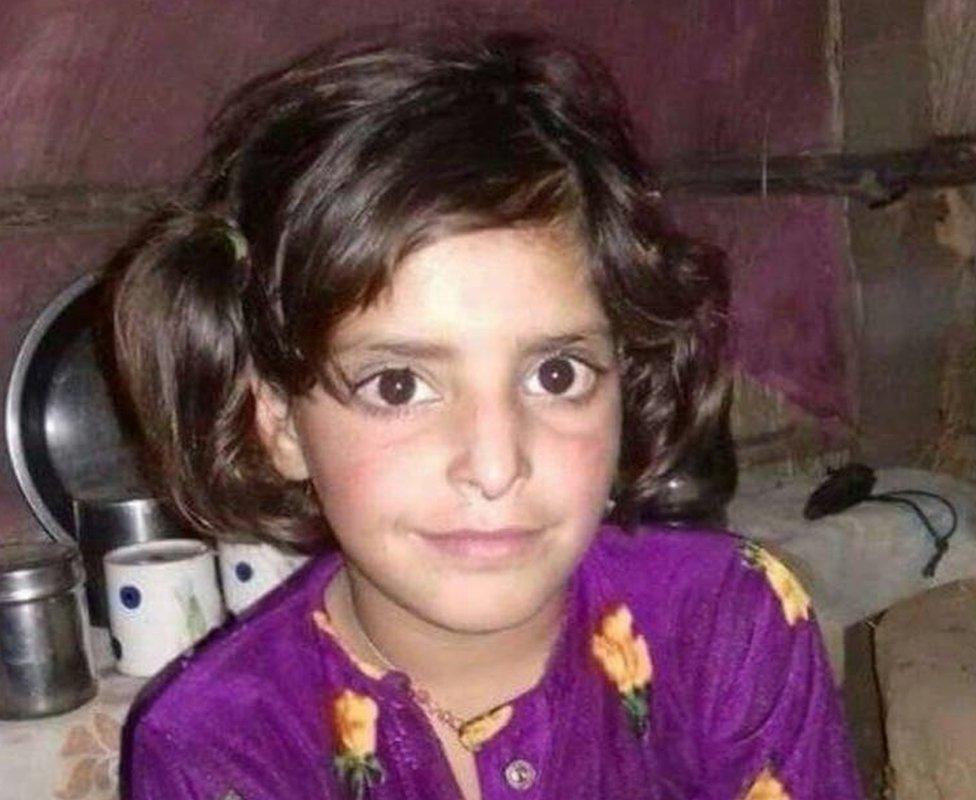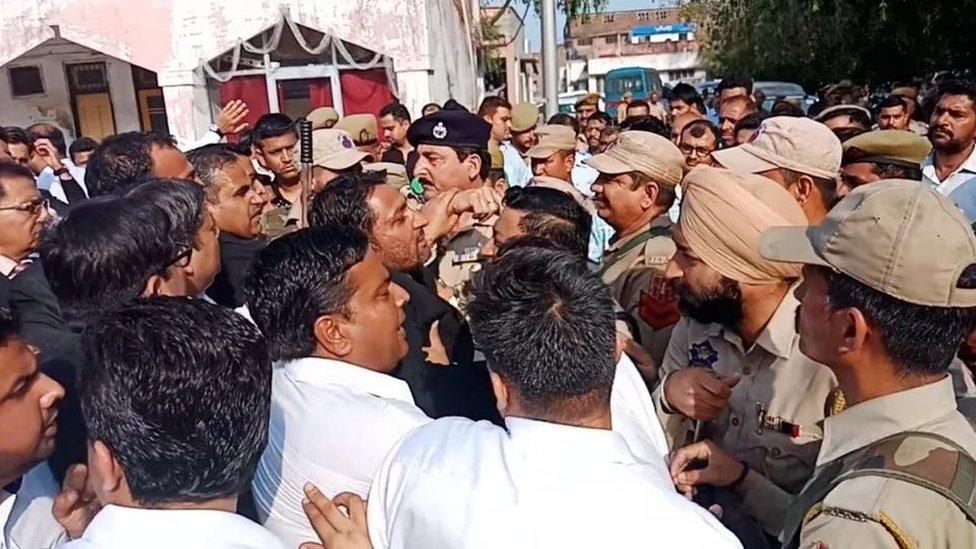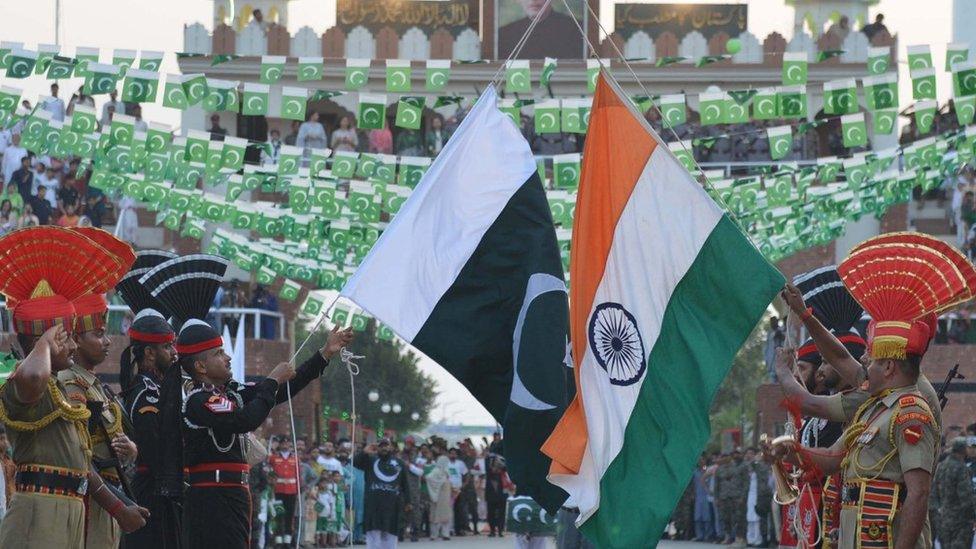Asifa Bano: The child rape and murder that has Kashmir on edge
- Published

Asifa Bano was eight years old
The brutal gang rape and murder of an eight-year-old girl in Indian-administered Kashmir has put the restive state on edge. Sameer Yasir, an independent journalist based in Srinagar, reports on how the investigation has split the region along religious lines.
On the morning of 17 January, Muhammad Yusuf Pujwala was sitting outside his home in Kathua when one of his neighbours came running towards him. He stopped in front of Mr Pujwala and broke the news: they had found his eight-year-old daughter, Asifa Bano. Her body lay in bushes in the forest, a few hundred metres away.
"I knew something horrible had happened to my girl," Mr Pujwala, a 52-year-old with deep sunken eyes, told the BBC in an interview recently. His wife, Naseema Bibi, sat beside him, faintly crying while repeatedly murmuring "Asifa".
Mr Pujwala belongs to a community of Muslim nomadic shepherds called Gujjars who crisscross the Himalayas with their goats and buffaloes.
The crime has shocked the community, exposing the fault lines between Hindu-majority Jammu and the Muslim-majority Kashmir valley in a sharply divided state. The Kashmir valley has a tumultuous relationship with India - there has been an armed revolt in the region against Indian rule since 1989.
Police have arrested eight men, including a retired government official, four police officers and a juvenile in connection with Asifa's death.
However, the arrests sparked protests in Jammu - lawyers tried to stop police entering the court, external to file a charge sheet and two ministers from the Hindu nationalist Bharatiya Janata Party (BJP) attended a rally in support of the accused., external
The BJP rules the state in a coalition with the regional People's Democratic Party (PDP).
How did Asifa disappear?
When she went missing on 10 January, her family was living in a village around 72km (45 miles) east of Jammu city. On that afternoon, her mother recalls, Asifa went to the forest to bring home the horses. The horses returned but Asifa did not.
Ms Naseema informed her husband. He and some neighbours started looking for her. Armed with flash lights, lanterns and axes, they went deep into the forest and searched through the night. But they could not find her.
Two days later, on 12 January, the family filed a police complaint. But, according to Mr Pujwala, the police were not helpful. One of the police officers, he alleges, said Asifa must have "eloped" with a boy.
As news of the crime spread, Gujjar staged protests and blocked a highway, forcing police to assign two officers for the search. One of those who was assigned, Deepak Khajuria, was himself arrested in connection with the crime.
Five days later, Asifa's body was found.
"She had been tortured. Her legs were broken," recalled Ms Naseema, who had rushed to the forest along with her husband to see the body. "Her nails had turned black and there were blue and red marks on her arm and fingers."
What do investigators believe happened?
On 23 January, six days after Asifa's body was found, the Jammu and Kashmir chief minister, Mehbooba Mufti, ordered a investigation by the crime branch, a special unit of the state police.
According to the investigators, Asifa was confined in a local temple for several days and given sedatives that kept her unconscious. The charge sheet alleges that she was "raped for days, tortured and then finally murdered". She was strangled to death and then hit on the head twice with a stone.
Sanji Ram, a 60-year-old retired government officer, allegedly planned the crime with the help of police officers Surender Verma, Anand Dutta, Tilak Raj and Mr Khajuria.

Lawyers in Jammu tried to stop police from entering the court to file a charge sheet
Mr Ram's son, Vishal, his nephew, a juvenile, and his friend, Parvesh Kumar, are also accused over the rape and murder.
Investigators allege that Mr Khajuria and the other police officers - some of whom lodged the complaint and accompanied the family in the search - washed Asifa's bloodied and mud-spattered clothes before sending them to a forensic lab.
They believe that the accused men wished to terrorise the Gujjar community into leaving Jammu. The shepherds use public and forest land in Jammu for grazing, which has recently brought them into conflict with some Hindu residents in the region.
"It was about land," said Talib Hussain, a tribal rights activist and lawyer. Mr Hussain, who led a protest in support of Asifa's family, alleges he was arrested and threatened by local police.
Ankur Sharma, one of the lawyers who protested on behalf of the accused, alleged that the Muslim nomads were trying to alter the demographics of Jammu, where Hindus are currently the majority. "They are encroaching our forests and water resources," he told the BBC. He said the accused had been falsely implicated while the real culprits were still free.
While the crime did not receive much attention in Jammu, newspapers in Srinagar, the capital city located in the Kashmir valley, carried the story on their front pages.
In Jammu and Kashmir state assembly, Mian Altaf, an influential Gujjar leader and an opposition legislator, waved the newspapers with photographs of Asifa while demanding an inquiry. Rajiv Jasrotia, a BJP lawmaker, said the incident was a "family matter" and blamed Mr Altaf for politicising the crime.
What happened at Asifa's funeral?
The Gujjars wanted to bury Asifa in a graveyard where they had purchased some land a few years ago and had already buried five people. But when they arrived there, Mr Pujwala said, they were surrounded by Hindu right-wing activists who threatened them with violence if they were to continue with the burial.
"We had to walk seven miles to bury her in another village," Mr Pujwala said. Two of his daughters were killed in an accident some years ago. On his wife's insistence, he adopted Asifa, the daughter of his brother-in-law.
His wife described Asifa as a "chirping bird" who ran like a "deer". When they travelled, she looked after the herd.
"That made her the darling of the community," Ms Bibi said. "She was the centre of our universe."
- Published28 October 2016

